Analysis of Change Management in Health and Social Care (BMHP6002)
VerifiedAdded on 2019/12/18
|12
|3846
|322
Report
AI Summary
This report examines the crucial aspects of leadership and management of change within the health and social care sector. It begins by describing modern change scenarios, emphasizing technological advancements and their impact on service delivery. The report explores the perceptions and beliefs of change among care organizations and users, highlighting varying attitudes towards new technologies and practices. It then evaluates the impact of change on managers, discussing positive and negative outcomes, and examines leadership theories like the Great Man theory and Trait theory. Furthermore, the report delves into the processes of change planning, implementation, and evaluation, focusing on reducing potential barriers and ensuring successful outcomes. The importance of effective management for driving change in health and social care settings is underscored throughout the analysis. The report uses Spire Healthcare as a case study to illustrate the practical application of these concepts and provides a comprehensive overview of change management strategies. The report is contributed by a student to be published on the website Desklib.
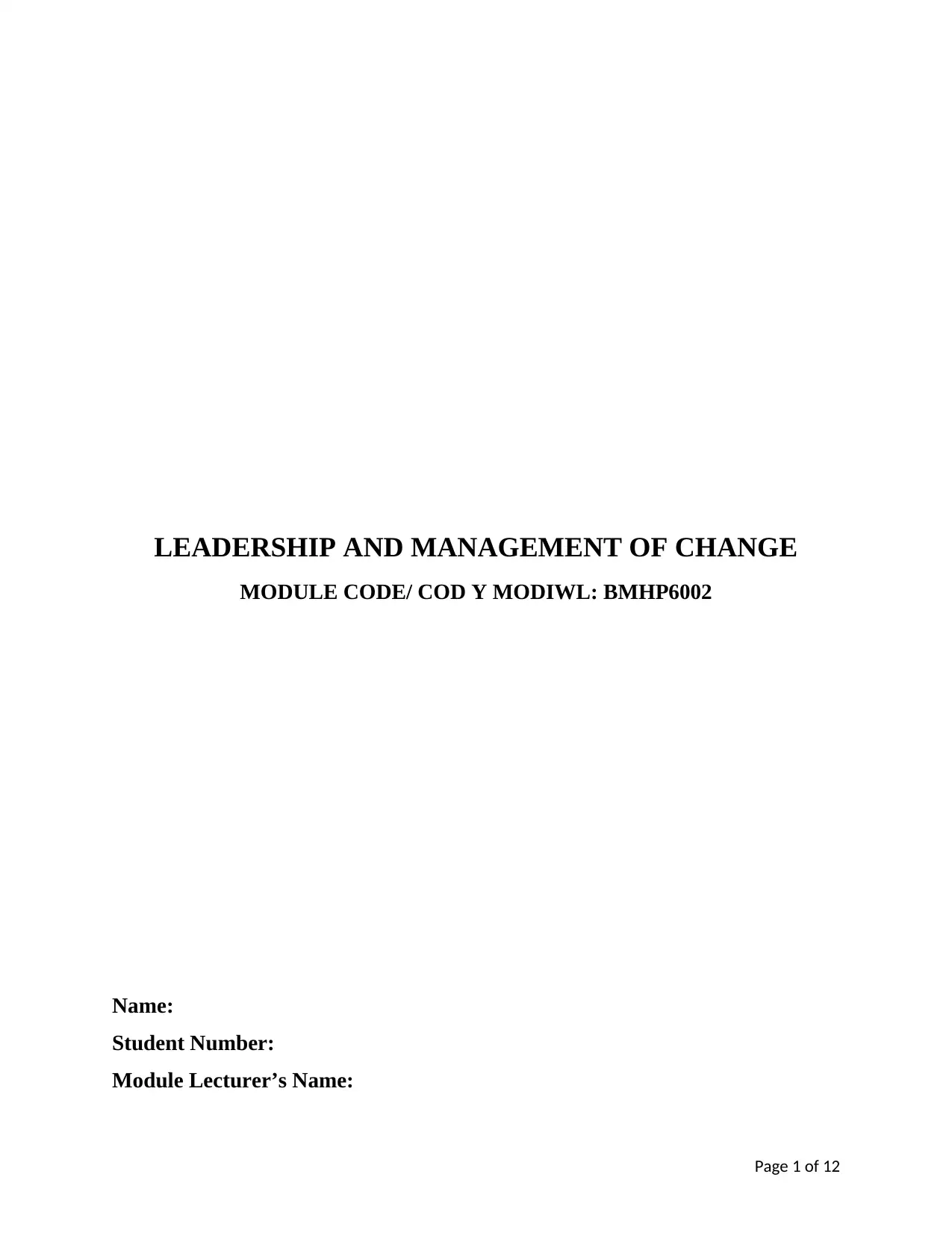
LEADERSHIP AND MANAGEMENT OF CHANGE
MODULE CODE/ COD Y MODIWL: BMHP6002
Name:
Student Number:
Module Lecturer’s Name:
Page 1 of 12
MODULE CODE/ COD Y MODIWL: BMHP6002
Name:
Student Number:
Module Lecturer’s Name:
Page 1 of 12
Paraphrase This Document
Need a fresh take? Get an instant paraphrase of this document with our AI Paraphraser
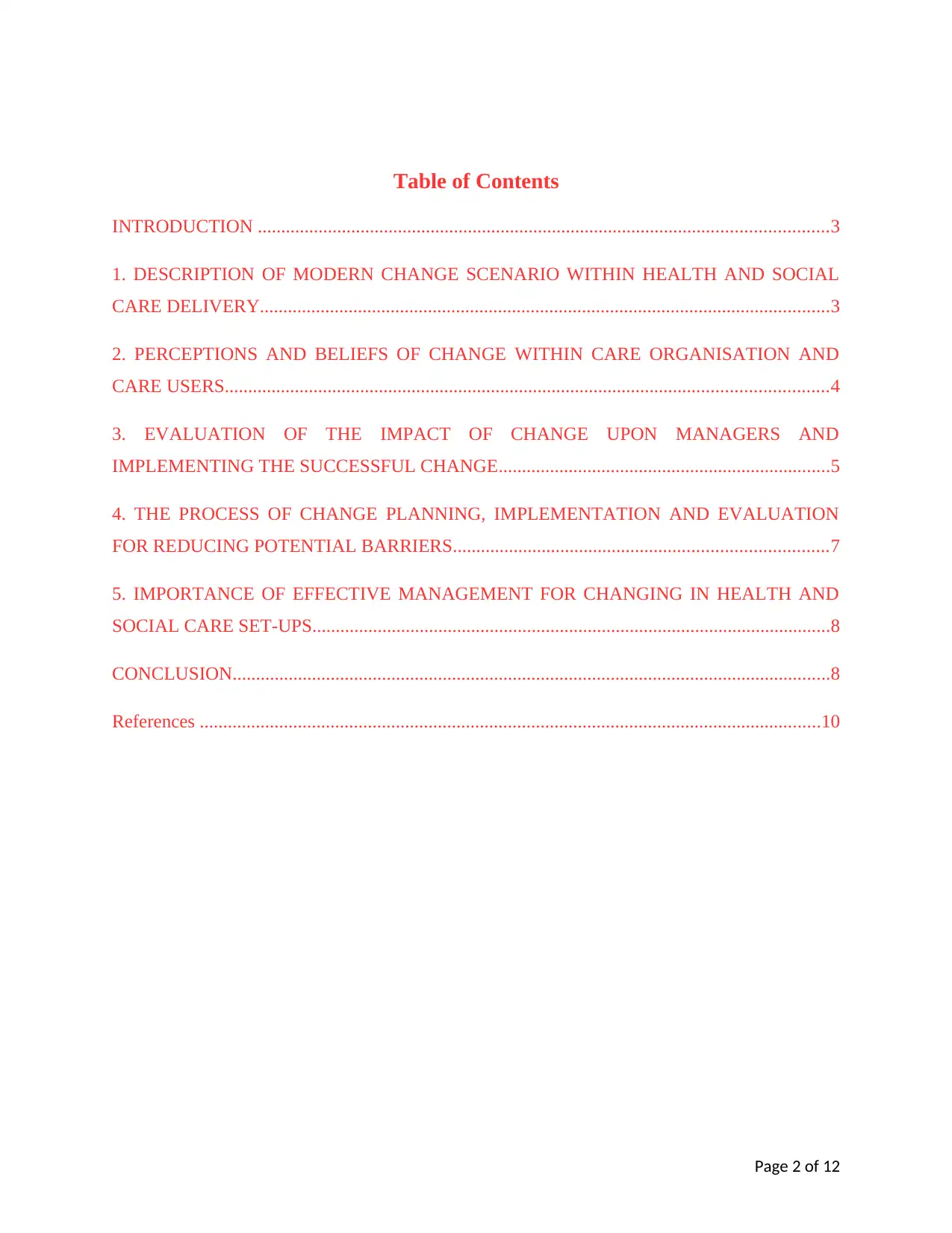
Table of Contents
INTRODUCTION ..........................................................................................................................3
1. DESCRIPTION OF MODERN CHANGE SCENARIO WITHIN HEALTH AND SOCIAL
CARE DELIVERY..........................................................................................................................3
2. PERCEPTIONS AND BELIEFS OF CHANGE WITHIN CARE ORGANISATION AND
CARE USERS.................................................................................................................................4
3. EVALUATION OF THE IMPACT OF CHANGE UPON MANAGERS AND
IMPLEMENTING THE SUCCESSFUL CHANGE.......................................................................5
4. THE PROCESS OF CHANGE PLANNING, IMPLEMENTATION AND EVALUATION
FOR REDUCING POTENTIAL BARRIERS................................................................................7
5. IMPORTANCE OF EFFECTIVE MANAGEMENT FOR CHANGING IN HEALTH AND
SOCIAL CARE SET-UPS...............................................................................................................8
CONCLUSION................................................................................................................................8
References .....................................................................................................................................10
Page 2 of 12
INTRODUCTION ..........................................................................................................................3
1. DESCRIPTION OF MODERN CHANGE SCENARIO WITHIN HEALTH AND SOCIAL
CARE DELIVERY..........................................................................................................................3
2. PERCEPTIONS AND BELIEFS OF CHANGE WITHIN CARE ORGANISATION AND
CARE USERS.................................................................................................................................4
3. EVALUATION OF THE IMPACT OF CHANGE UPON MANAGERS AND
IMPLEMENTING THE SUCCESSFUL CHANGE.......................................................................5
4. THE PROCESS OF CHANGE PLANNING, IMPLEMENTATION AND EVALUATION
FOR REDUCING POTENTIAL BARRIERS................................................................................7
5. IMPORTANCE OF EFFECTIVE MANAGEMENT FOR CHANGING IN HEALTH AND
SOCIAL CARE SET-UPS...............................................................................................................8
CONCLUSION................................................................................................................................8
References .....................................................................................................................................10
Page 2 of 12
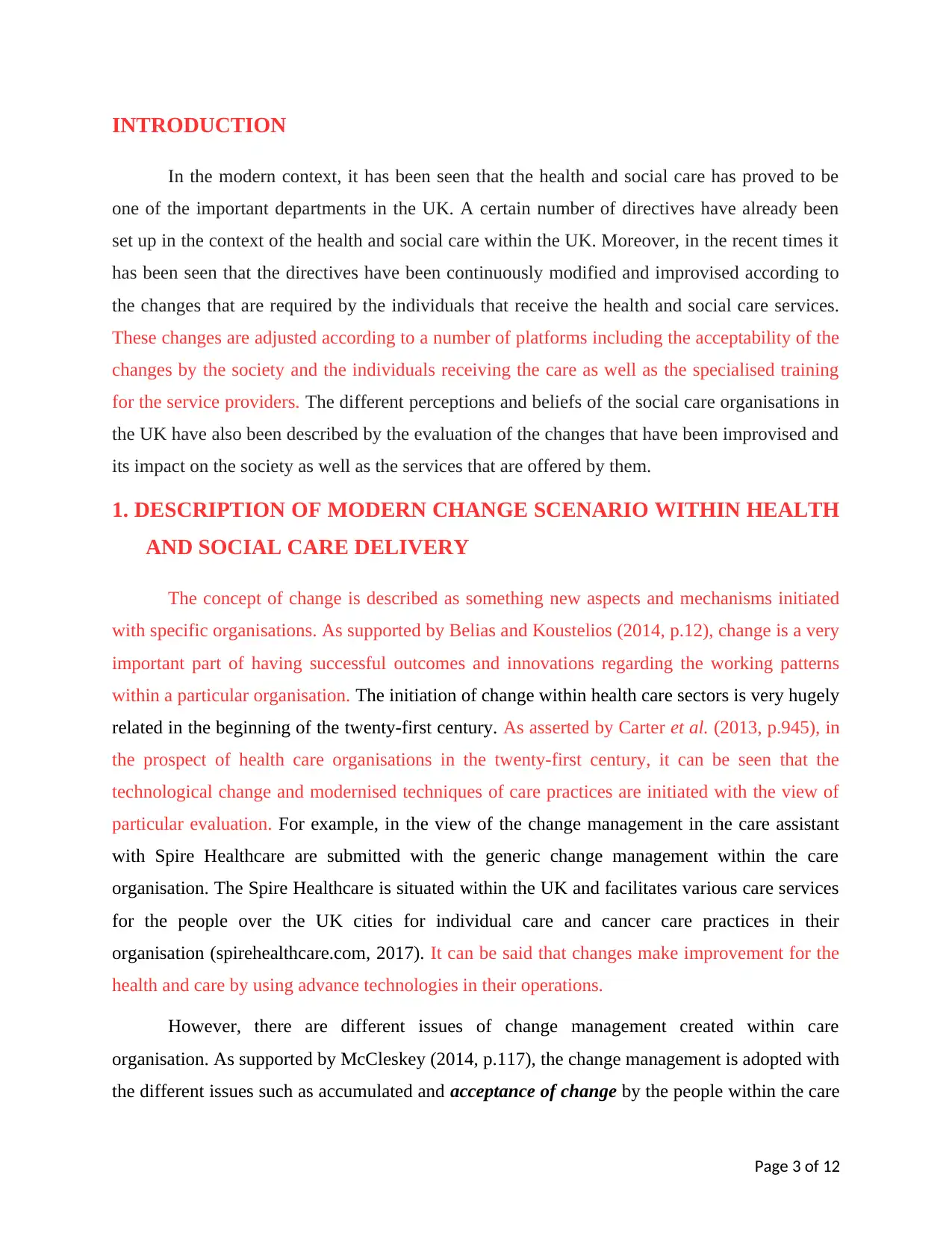
INTRODUCTION
In the modern context, it has been seen that the health and social care has proved to be
one of the important departments in the UK. A certain number of directives have already been
set up in the context of the health and social care within the UK. Moreover, in the recent times it
has been seen that the directives have been continuously modified and improvised according to
the changes that are required by the individuals that receive the health and social care services.
These changes are adjusted according to a number of platforms including the acceptability of the
changes by the society and the individuals receiving the care as well as the specialised training
for the service providers. The different perceptions and beliefs of the social care organisations in
the UK have also been described by the evaluation of the changes that have been improvised and
its impact on the society as well as the services that are offered by them.
1. DESCRIPTION OF MODERN CHANGE SCENARIO WITHIN HEALTH
AND SOCIAL CARE DELIVERY
The concept of change is described as something new aspects and mechanisms initiated
with specific organisations. As supported by Belias and Koustelios (2014, p.12), change is a very
important part of having successful outcomes and innovations regarding the working patterns
within a particular organisation. The initiation of change within health care sectors is very hugely
related in the beginning of the twenty-first century. As asserted by Carter et al. (2013, p.945), in
the prospect of health care organisations in the twenty-first century, it can be seen that the
technological change and modernised techniques of care practices are initiated with the view of
particular evaluation. For example, in the view of the change management in the care assistant
with Spire Healthcare are submitted with the generic change management within the care
organisation. The Spire Healthcare is situated within the UK and facilitates various care services
for the people over the UK cities for individual care and cancer care practices in their
organisation (spirehealthcare.com, 2017). It can be said that changes make improvement for the
health and care by using advance technologies in their operations.
However, there are different issues of change management created within care
organisation. As supported by McCleskey (2014, p.117), the change management is adopted with
the different issues such as accumulated and acceptance of change by the people within the care
Page 3 of 12
In the modern context, it has been seen that the health and social care has proved to be
one of the important departments in the UK. A certain number of directives have already been
set up in the context of the health and social care within the UK. Moreover, in the recent times it
has been seen that the directives have been continuously modified and improvised according to
the changes that are required by the individuals that receive the health and social care services.
These changes are adjusted according to a number of platforms including the acceptability of the
changes by the society and the individuals receiving the care as well as the specialised training
for the service providers. The different perceptions and beliefs of the social care organisations in
the UK have also been described by the evaluation of the changes that have been improvised and
its impact on the society as well as the services that are offered by them.
1. DESCRIPTION OF MODERN CHANGE SCENARIO WITHIN HEALTH
AND SOCIAL CARE DELIVERY
The concept of change is described as something new aspects and mechanisms initiated
with specific organisations. As supported by Belias and Koustelios (2014, p.12), change is a very
important part of having successful outcomes and innovations regarding the working patterns
within a particular organisation. The initiation of change within health care sectors is very hugely
related in the beginning of the twenty-first century. As asserted by Carter et al. (2013, p.945), in
the prospect of health care organisations in the twenty-first century, it can be seen that the
technological change and modernised techniques of care practices are initiated with the view of
particular evaluation. For example, in the view of the change management in the care assistant
with Spire Healthcare are submitted with the generic change management within the care
organisation. The Spire Healthcare is situated within the UK and facilitates various care services
for the people over the UK cities for individual care and cancer care practices in their
organisation (spirehealthcare.com, 2017). It can be said that changes make improvement for the
health and care by using advance technologies in their operations.
However, there are different issues of change management created within care
organisation. As supported by McCleskey (2014, p.117), the change management is adopted with
the different issues such as accumulated and acceptance of change by the people within the care
Page 3 of 12
⊘ This is a preview!⊘
Do you want full access?
Subscribe today to unlock all pages.

Trusted by 1+ million students worldwide
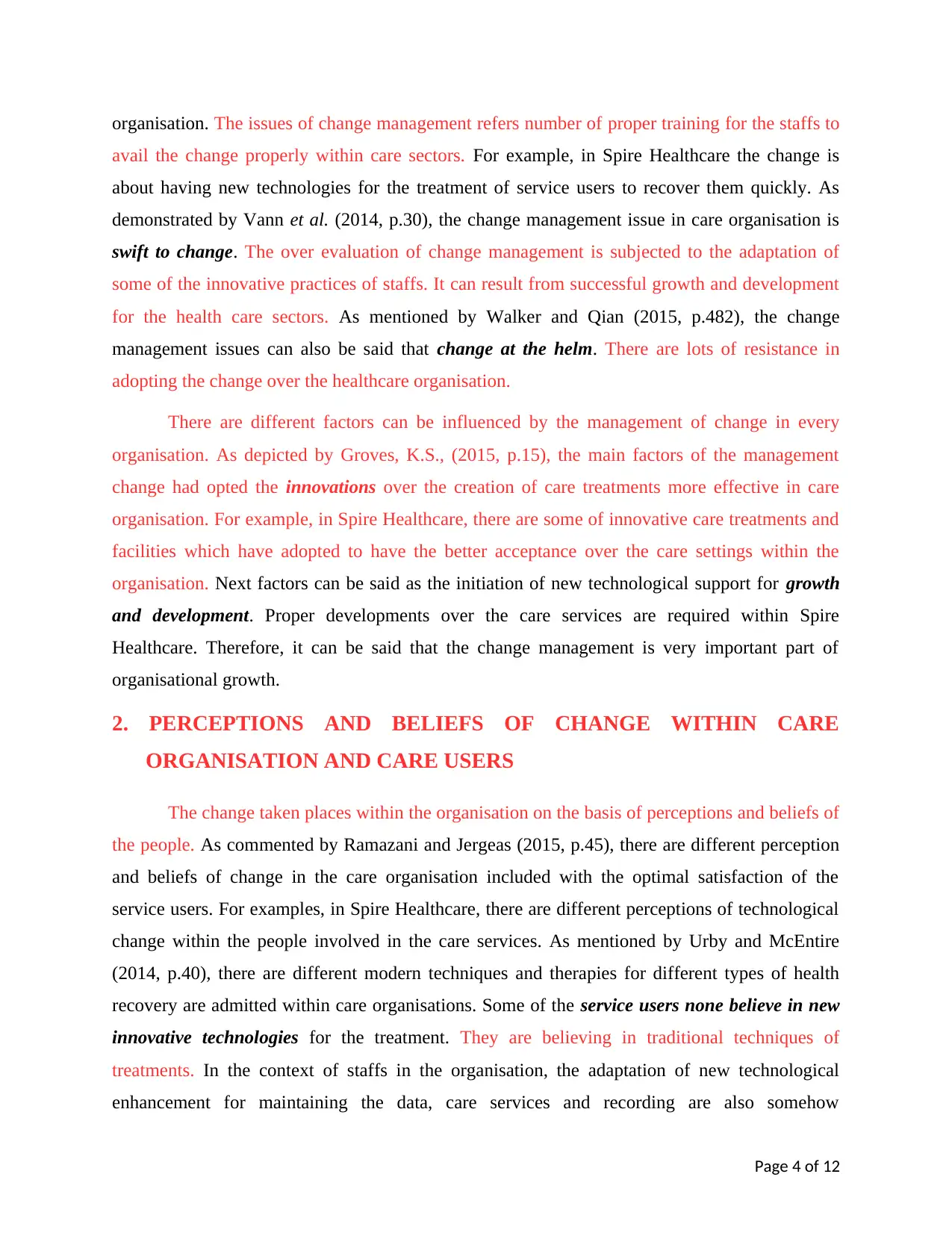
organisation. The issues of change management refers number of proper training for the staffs to
avail the change properly within care sectors. For example, in Spire Healthcare the change is
about having new technologies for the treatment of service users to recover them quickly. As
demonstrated by Vann et al. (2014, p.30), the change management issue in care organisation is
swift to change. The over evaluation of change management is subjected to the adaptation of
some of the innovative practices of staffs. It can result from successful growth and development
for the health care sectors. As mentioned by Walker and Qian (2015, p.482), the change
management issues can also be said that change at the helm. There are lots of resistance in
adopting the change over the healthcare organisation.
There are different factors can be influenced by the management of change in every
organisation. As depicted by Groves, K.S., (2015, p.15), the main factors of the management
change had opted the innovations over the creation of care treatments more effective in care
organisation. For example, in Spire Healthcare, there are some of innovative care treatments and
facilities which have adopted to have the better acceptance over the care settings within the
organisation. Next factors can be said as the initiation of new technological support for growth
and development. Proper developments over the care services are required within Spire
Healthcare. Therefore, it can be said that the change management is very important part of
organisational growth.
2. PERCEPTIONS AND BELIEFS OF CHANGE WITHIN CARE
ORGANISATION AND CARE USERS
The change taken places within the organisation on the basis of perceptions and beliefs of
the people. As commented by Ramazani and Jergeas (2015, p.45), there are different perception
and beliefs of change in the care organisation included with the optimal satisfaction of the
service users. For examples, in Spire Healthcare, there are different perceptions of technological
change within the people involved in the care services. As mentioned by Urby and McEntire
(2014, p.40), there are different modern techniques and therapies for different types of health
recovery are admitted within care organisations. Some of the service users none believe in new
innovative technologies for the treatment. They are believing in traditional techniques of
treatments. In the context of staffs in the organisation, the adaptation of new technological
enhancement for maintaining the data, care services and recording are also somehow
Page 4 of 12
avail the change properly within care sectors. For example, in Spire Healthcare the change is
about having new technologies for the treatment of service users to recover them quickly. As
demonstrated by Vann et al. (2014, p.30), the change management issue in care organisation is
swift to change. The over evaluation of change management is subjected to the adaptation of
some of the innovative practices of staffs. It can result from successful growth and development
for the health care sectors. As mentioned by Walker and Qian (2015, p.482), the change
management issues can also be said that change at the helm. There are lots of resistance in
adopting the change over the healthcare organisation.
There are different factors can be influenced by the management of change in every
organisation. As depicted by Groves, K.S., (2015, p.15), the main factors of the management
change had opted the innovations over the creation of care treatments more effective in care
organisation. For example, in Spire Healthcare, there are some of innovative care treatments and
facilities which have adopted to have the better acceptance over the care settings within the
organisation. Next factors can be said as the initiation of new technological support for growth
and development. Proper developments over the care services are required within Spire
Healthcare. Therefore, it can be said that the change management is very important part of
organisational growth.
2. PERCEPTIONS AND BELIEFS OF CHANGE WITHIN CARE
ORGANISATION AND CARE USERS
The change taken places within the organisation on the basis of perceptions and beliefs of
the people. As commented by Ramazani and Jergeas (2015, p.45), there are different perception
and beliefs of change in the care organisation included with the optimal satisfaction of the
service users. For examples, in Spire Healthcare, there are different perceptions of technological
change within the people involved in the care services. As mentioned by Urby and McEntire
(2014, p.40), there are different modern techniques and therapies for different types of health
recovery are admitted within care organisations. Some of the service users none believe in new
innovative technologies for the treatment. They are believing in traditional techniques of
treatments. In the context of staffs in the organisation, the adaptation of new technological
enhancement for maintaining the data, care services and recording are also somehow
Page 4 of 12
Paraphrase This Document
Need a fresh take? Get an instant paraphrase of this document with our AI Paraphraser
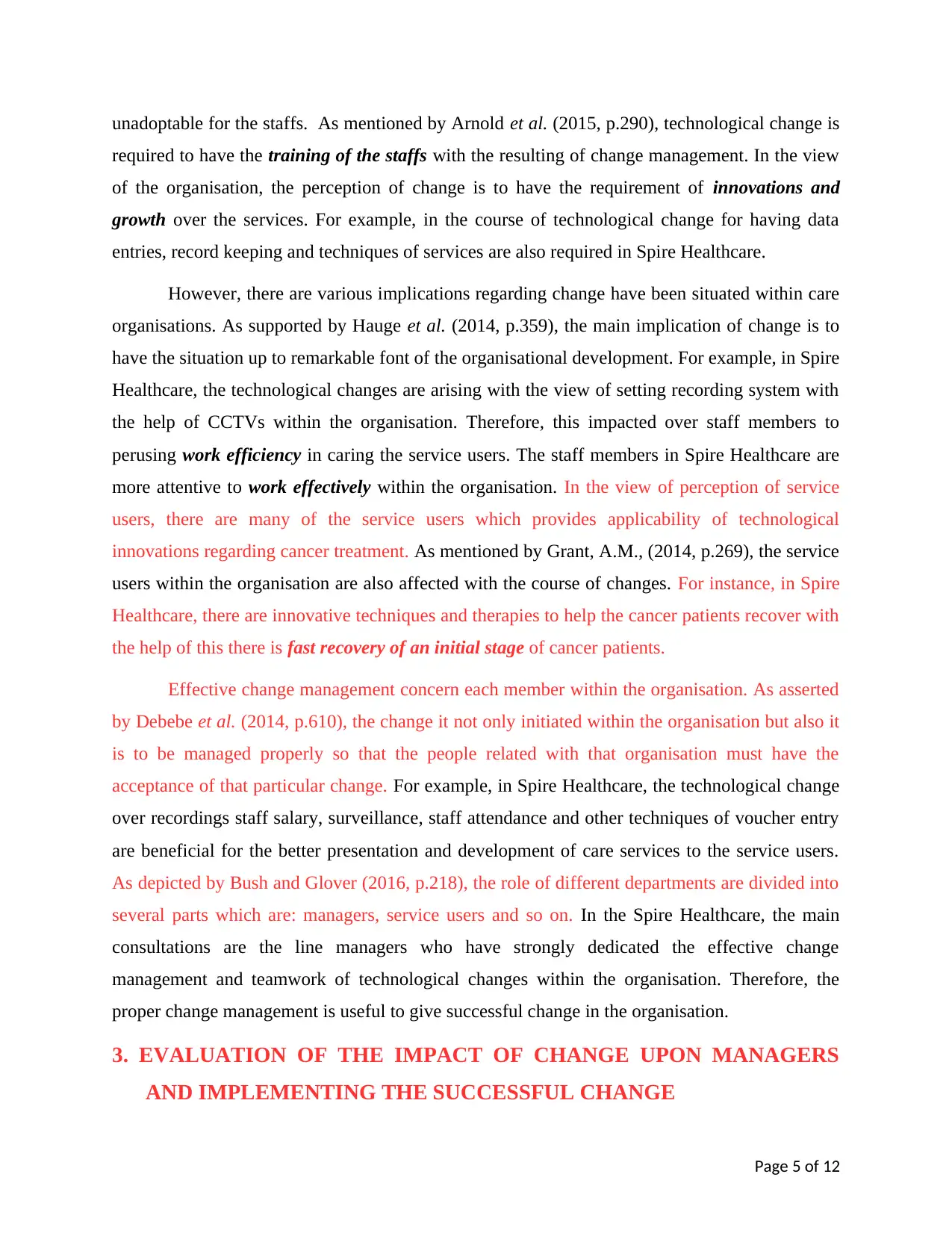
unadoptable for the staffs. As mentioned by Arnold et al. (2015, p.290), technological change is
required to have the training of the staffs with the resulting of change management. In the view
of the organisation, the perception of change is to have the requirement of innovations and
growth over the services. For example, in the course of technological change for having data
entries, record keeping and techniques of services are also required in Spire Healthcare.
However, there are various implications regarding change have been situated within care
organisations. As supported by Hauge et al. (2014, p.359), the main implication of change is to
have the situation up to remarkable font of the organisational development. For example, in Spire
Healthcare, the technological changes are arising with the view of setting recording system with
the help of CCTVs within the organisation. Therefore, this impacted over staff members to
perusing work efficiency in caring the service users. The staff members in Spire Healthcare are
more attentive to work effectively within the organisation. In the view of perception of service
users, there are many of the service users which provides applicability of technological
innovations regarding cancer treatment. As mentioned by Grant, A.M., (2014, p.269), the service
users within the organisation are also affected with the course of changes. For instance, in Spire
Healthcare, there are innovative techniques and therapies to help the cancer patients recover with
the help of this there is fast recovery of an initial stage of cancer patients.
Effective change management concern each member within the organisation. As asserted
by Debebe et al. (2014, p.610), the change it not only initiated within the organisation but also it
is to be managed properly so that the people related with that organisation must have the
acceptance of that particular change. For example, in Spire Healthcare, the technological change
over recordings staff salary, surveillance, staff attendance and other techniques of voucher entry
are beneficial for the better presentation and development of care services to the service users.
As depicted by Bush and Glover (2016, p.218), the role of different departments are divided into
several parts which are: managers, service users and so on. In the Spire Healthcare, the main
consultations are the line managers who have strongly dedicated the effective change
management and teamwork of technological changes within the organisation. Therefore, the
proper change management is useful to give successful change in the organisation.
3. EVALUATION OF THE IMPACT OF CHANGE UPON MANAGERS
AND IMPLEMENTING THE SUCCESSFUL CHANGE
Page 5 of 12
required to have the training of the staffs with the resulting of change management. In the view
of the organisation, the perception of change is to have the requirement of innovations and
growth over the services. For example, in the course of technological change for having data
entries, record keeping and techniques of services are also required in Spire Healthcare.
However, there are various implications regarding change have been situated within care
organisations. As supported by Hauge et al. (2014, p.359), the main implication of change is to
have the situation up to remarkable font of the organisational development. For example, in Spire
Healthcare, the technological changes are arising with the view of setting recording system with
the help of CCTVs within the organisation. Therefore, this impacted over staff members to
perusing work efficiency in caring the service users. The staff members in Spire Healthcare are
more attentive to work effectively within the organisation. In the view of perception of service
users, there are many of the service users which provides applicability of technological
innovations regarding cancer treatment. As mentioned by Grant, A.M., (2014, p.269), the service
users within the organisation are also affected with the course of changes. For instance, in Spire
Healthcare, there are innovative techniques and therapies to help the cancer patients recover with
the help of this there is fast recovery of an initial stage of cancer patients.
Effective change management concern each member within the organisation. As asserted
by Debebe et al. (2014, p.610), the change it not only initiated within the organisation but also it
is to be managed properly so that the people related with that organisation must have the
acceptance of that particular change. For example, in Spire Healthcare, the technological change
over recordings staff salary, surveillance, staff attendance and other techniques of voucher entry
are beneficial for the better presentation and development of care services to the service users.
As depicted by Bush and Glover (2016, p.218), the role of different departments are divided into
several parts which are: managers, service users and so on. In the Spire Healthcare, the main
consultations are the line managers who have strongly dedicated the effective change
management and teamwork of technological changes within the organisation. Therefore, the
proper change management is useful to give successful change in the organisation.
3. EVALUATION OF THE IMPACT OF CHANGE UPON MANAGERS
AND IMPLEMENTING THE SUCCESSFUL CHANGE
Page 5 of 12
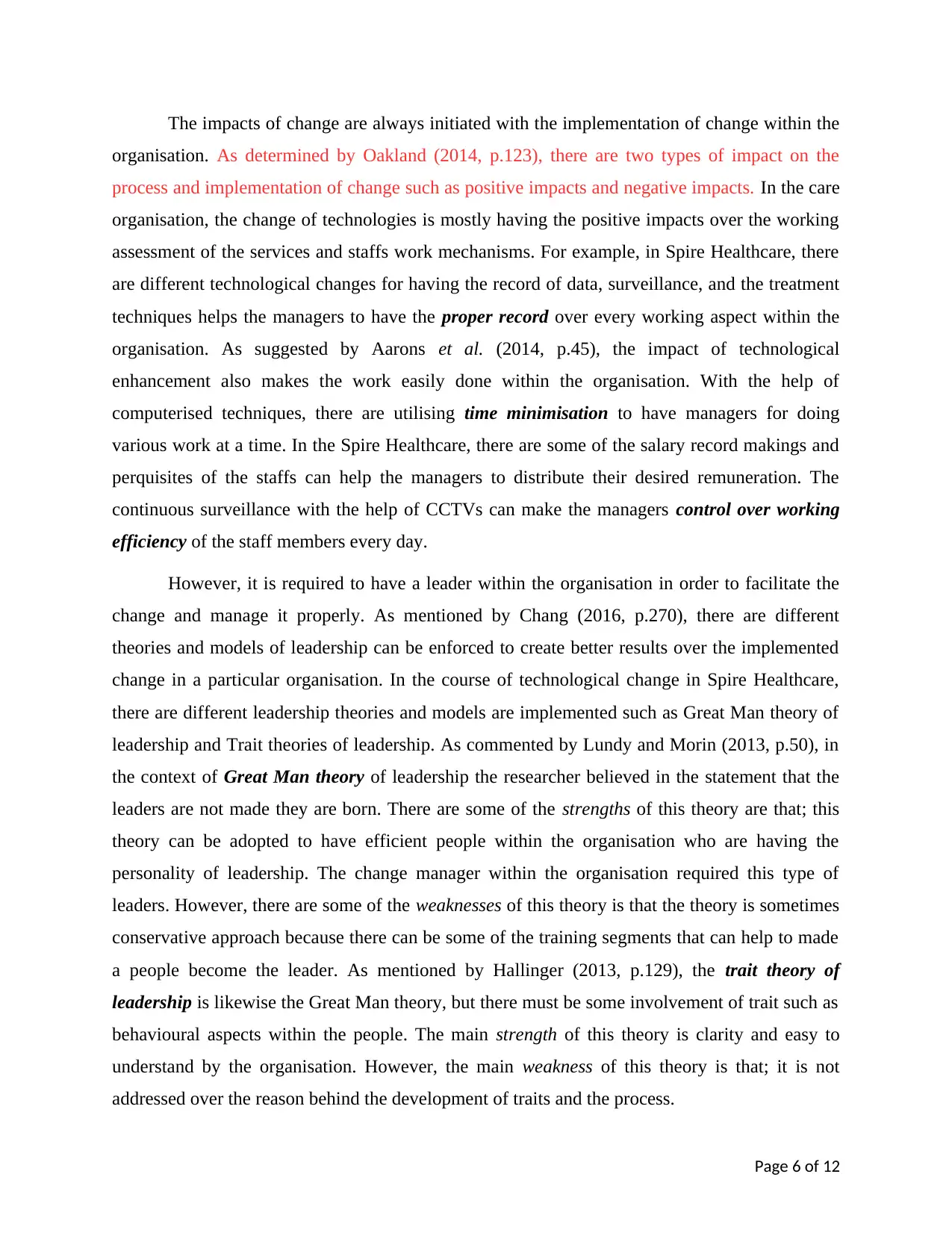
The impacts of change are always initiated with the implementation of change within the
organisation. As determined by Oakland (2014, p.123), there are two types of impact on the
process and implementation of change such as positive impacts and negative impacts. In the care
organisation, the change of technologies is mostly having the positive impacts over the working
assessment of the services and staffs work mechanisms. For example, in Spire Healthcare, there
are different technological changes for having the record of data, surveillance, and the treatment
techniques helps the managers to have the proper record over every working aspect within the
organisation. As suggested by Aarons et al. (2014, p.45), the impact of technological
enhancement also makes the work easily done within the organisation. With the help of
computerised techniques, there are utilising time minimisation to have managers for doing
various work at a time. In the Spire Healthcare, there are some of the salary record makings and
perquisites of the staffs can help the managers to distribute their desired remuneration. The
continuous surveillance with the help of CCTVs can make the managers control over working
efficiency of the staff members every day.
However, it is required to have a leader within the organisation in order to facilitate the
change and manage it properly. As mentioned by Chang (2016, p.270), there are different
theories and models of leadership can be enforced to create better results over the implemented
change in a particular organisation. In the course of technological change in Spire Healthcare,
there are different leadership theories and models are implemented such as Great Man theory of
leadership and Trait theories of leadership. As commented by Lundy and Morin (2013, p.50), in
the context of Great Man theory of leadership the researcher believed in the statement that the
leaders are not made they are born. There are some of the strengths of this theory are that; this
theory can be adopted to have efficient people within the organisation who are having the
personality of leadership. The change manager within the organisation required this type of
leaders. However, there are some of the weaknesses of this theory is that the theory is sometimes
conservative approach because there can be some of the training segments that can help to made
a people become the leader. As mentioned by Hallinger (2013, p.129), the trait theory of
leadership is likewise the Great Man theory, but there must be some involvement of trait such as
behavioural aspects within the people. The main strength of this theory is clarity and easy to
understand by the organisation. However, the main weakness of this theory is that; it is not
addressed over the reason behind the development of traits and the process.
Page 6 of 12
organisation. As determined by Oakland (2014, p.123), there are two types of impact on the
process and implementation of change such as positive impacts and negative impacts. In the care
organisation, the change of technologies is mostly having the positive impacts over the working
assessment of the services and staffs work mechanisms. For example, in Spire Healthcare, there
are different technological changes for having the record of data, surveillance, and the treatment
techniques helps the managers to have the proper record over every working aspect within the
organisation. As suggested by Aarons et al. (2014, p.45), the impact of technological
enhancement also makes the work easily done within the organisation. With the help of
computerised techniques, there are utilising time minimisation to have managers for doing
various work at a time. In the Spire Healthcare, there are some of the salary record makings and
perquisites of the staffs can help the managers to distribute their desired remuneration. The
continuous surveillance with the help of CCTVs can make the managers control over working
efficiency of the staff members every day.
However, it is required to have a leader within the organisation in order to facilitate the
change and manage it properly. As mentioned by Chang (2016, p.270), there are different
theories and models of leadership can be enforced to create better results over the implemented
change in a particular organisation. In the course of technological change in Spire Healthcare,
there are different leadership theories and models are implemented such as Great Man theory of
leadership and Trait theories of leadership. As commented by Lundy and Morin (2013, p.50), in
the context of Great Man theory of leadership the researcher believed in the statement that the
leaders are not made they are born. There are some of the strengths of this theory are that; this
theory can be adopted to have efficient people within the organisation who are having the
personality of leadership. The change manager within the organisation required this type of
leaders. However, there are some of the weaknesses of this theory is that the theory is sometimes
conservative approach because there can be some of the training segments that can help to made
a people become the leader. As mentioned by Hallinger (2013, p.129), the trait theory of
leadership is likewise the Great Man theory, but there must be some involvement of trait such as
behavioural aspects within the people. The main strength of this theory is clarity and easy to
understand by the organisation. However, the main weakness of this theory is that; it is not
addressed over the reason behind the development of traits and the process.
Page 6 of 12
⊘ This is a preview!⊘
Do you want full access?
Subscribe today to unlock all pages.

Trusted by 1+ million students worldwide
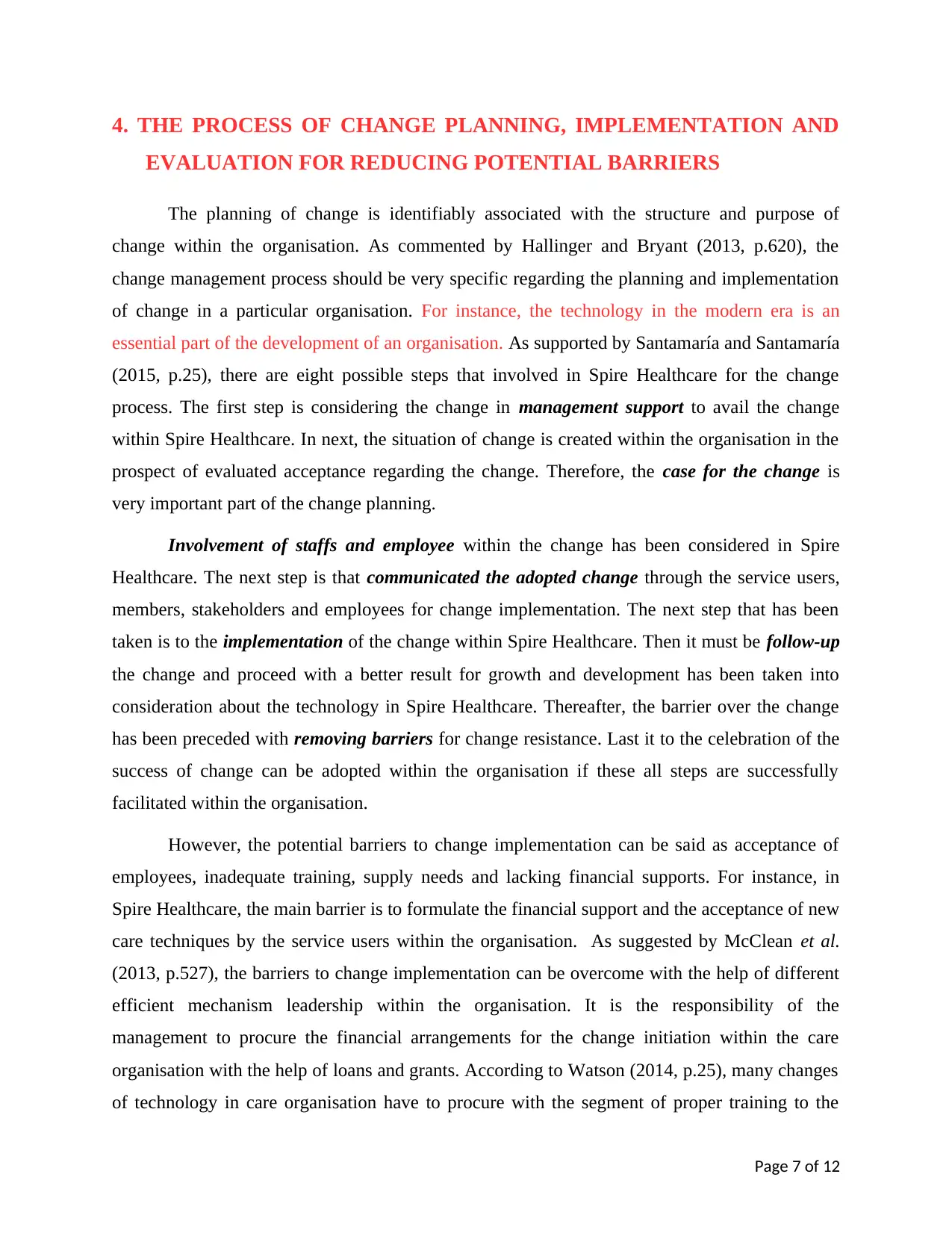
4. THE PROCESS OF CHANGE PLANNING, IMPLEMENTATION AND
EVALUATION FOR REDUCING POTENTIAL BARRIERS
The planning of change is identifiably associated with the structure and purpose of
change within the organisation. As commented by Hallinger and Bryant (2013, p.620), the
change management process should be very specific regarding the planning and implementation
of change in a particular organisation. For instance, the technology in the modern era is an
essential part of the development of an organisation. As supported by Santamaría and Santamaría
(2015, p.25), there are eight possible steps that involved in Spire Healthcare for the change
process. The first step is considering the change in management support to avail the change
within Spire Healthcare. In next, the situation of change is created within the organisation in the
prospect of evaluated acceptance regarding the change. Therefore, the case for the change is
very important part of the change planning.
Involvement of staffs and employee within the change has been considered in Spire
Healthcare. The next step is that communicated the adopted change through the service users,
members, stakeholders and employees for change implementation. The next step that has been
taken is to the implementation of the change within Spire Healthcare. Then it must be follow-up
the change and proceed with a better result for growth and development has been taken into
consideration about the technology in Spire Healthcare. Thereafter, the barrier over the change
has been preceded with removing barriers for change resistance. Last it to the celebration of the
success of change can be adopted within the organisation if these all steps are successfully
facilitated within the organisation.
However, the potential barriers to change implementation can be said as acceptance of
employees, inadequate training, supply needs and lacking financial supports. For instance, in
Spire Healthcare, the main barrier is to formulate the financial support and the acceptance of new
care techniques by the service users within the organisation. As suggested by McClean et al.
(2013, p.527), the barriers to change implementation can be overcome with the help of different
efficient mechanism leadership within the organisation. It is the responsibility of the
management to procure the financial arrangements for the change initiation within the care
organisation with the help of loans and grants. According to Watson (2014, p.25), many changes
of technology in care organisation have to procure with the segment of proper training to the
Page 7 of 12
EVALUATION FOR REDUCING POTENTIAL BARRIERS
The planning of change is identifiably associated with the structure and purpose of
change within the organisation. As commented by Hallinger and Bryant (2013, p.620), the
change management process should be very specific regarding the planning and implementation
of change in a particular organisation. For instance, the technology in the modern era is an
essential part of the development of an organisation. As supported by Santamaría and Santamaría
(2015, p.25), there are eight possible steps that involved in Spire Healthcare for the change
process. The first step is considering the change in management support to avail the change
within Spire Healthcare. In next, the situation of change is created within the organisation in the
prospect of evaluated acceptance regarding the change. Therefore, the case for the change is
very important part of the change planning.
Involvement of staffs and employee within the change has been considered in Spire
Healthcare. The next step is that communicated the adopted change through the service users,
members, stakeholders and employees for change implementation. The next step that has been
taken is to the implementation of the change within Spire Healthcare. Then it must be follow-up
the change and proceed with a better result for growth and development has been taken into
consideration about the technology in Spire Healthcare. Thereafter, the barrier over the change
has been preceded with removing barriers for change resistance. Last it to the celebration of the
success of change can be adopted within the organisation if these all steps are successfully
facilitated within the organisation.
However, the potential barriers to change implementation can be said as acceptance of
employees, inadequate training, supply needs and lacking financial supports. For instance, in
Spire Healthcare, the main barrier is to formulate the financial support and the acceptance of new
care techniques by the service users within the organisation. As suggested by McClean et al.
(2013, p.527), the barriers to change implementation can be overcome with the help of different
efficient mechanism leadership within the organisation. It is the responsibility of the
management to procure the financial arrangements for the change initiation within the care
organisation with the help of loans and grants. According to Watson (2014, p.25), many changes
of technology in care organisation have to procure with the segment of proper training to the
Page 7 of 12
Paraphrase This Document
Need a fresh take? Get an instant paraphrase of this document with our AI Paraphraser
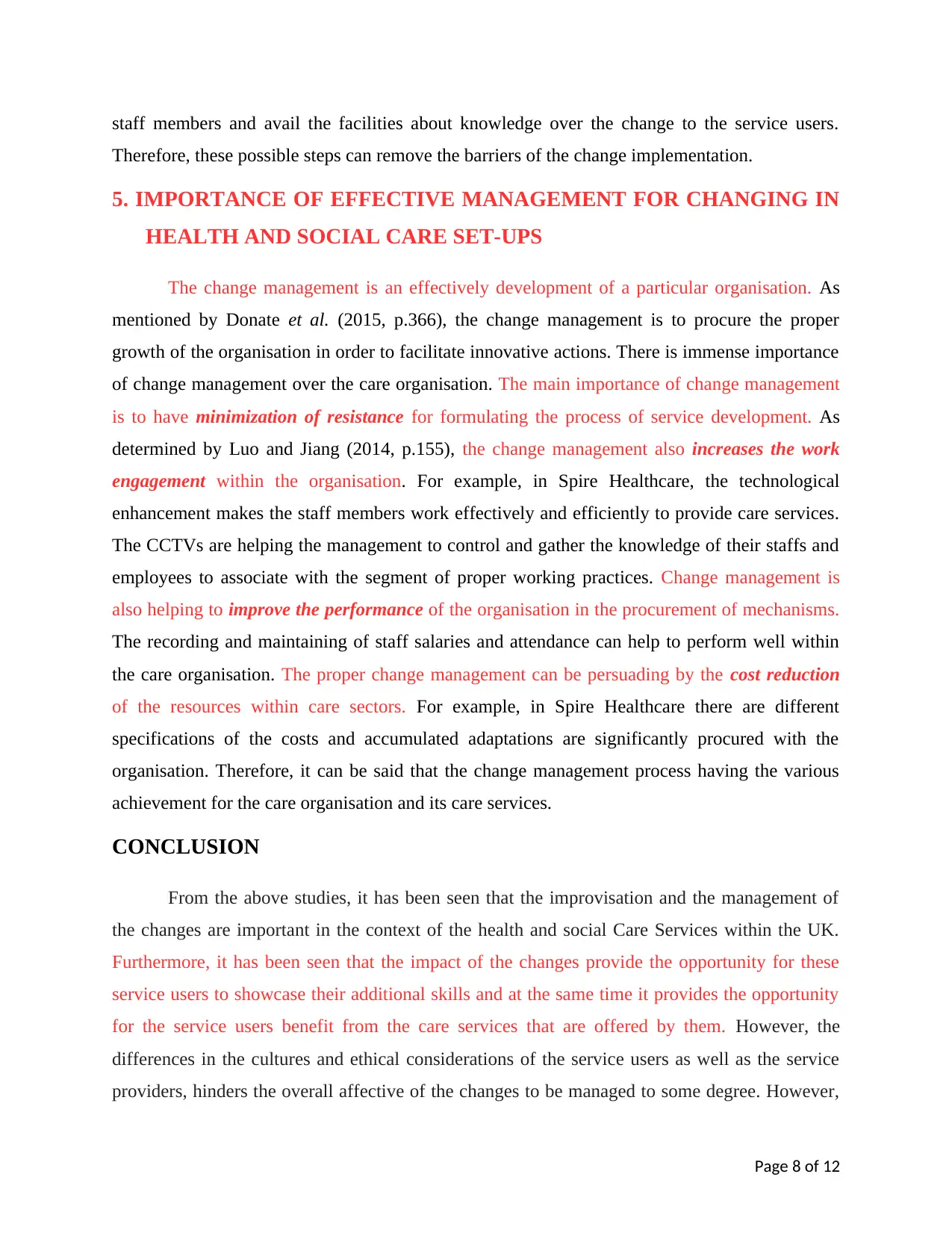
staff members and avail the facilities about knowledge over the change to the service users.
Therefore, these possible steps can remove the barriers of the change implementation.
5. IMPORTANCE OF EFFECTIVE MANAGEMENT FOR CHANGING IN
HEALTH AND SOCIAL CARE SET-UPS
The change management is an effectively development of a particular organisation. As
mentioned by Donate et al. (2015, p.366), the change management is to procure the proper
growth of the organisation in order to facilitate innovative actions. There is immense importance
of change management over the care organisation. The main importance of change management
is to have minimization of resistance for formulating the process of service development. As
determined by Luo and Jiang (2014, p.155), the change management also increases the work
engagement within the organisation. For example, in Spire Healthcare, the technological
enhancement makes the staff members work effectively and efficiently to provide care services.
The CCTVs are helping the management to control and gather the knowledge of their staffs and
employees to associate with the segment of proper working practices. Change management is
also helping to improve the performance of the organisation in the procurement of mechanisms.
The recording and maintaining of staff salaries and attendance can help to perform well within
the care organisation. The proper change management can be persuading by the cost reduction
of the resources within care sectors. For example, in Spire Healthcare there are different
specifications of the costs and accumulated adaptations are significantly procured with the
organisation. Therefore, it can be said that the change management process having the various
achievement for the care organisation and its care services.
CONCLUSION
From the above studies, it has been seen that the improvisation and the management of
the changes are important in the context of the health and social Care Services within the UK.
Furthermore, it has been seen that the impact of the changes provide the opportunity for these
service users to showcase their additional skills and at the same time it provides the opportunity
for the service users benefit from the care services that are offered by them. However, the
differences in the cultures and ethical considerations of the service users as well as the service
providers, hinders the overall affective of the changes to be managed to some degree. However,
Page 8 of 12
Therefore, these possible steps can remove the barriers of the change implementation.
5. IMPORTANCE OF EFFECTIVE MANAGEMENT FOR CHANGING IN
HEALTH AND SOCIAL CARE SET-UPS
The change management is an effectively development of a particular organisation. As
mentioned by Donate et al. (2015, p.366), the change management is to procure the proper
growth of the organisation in order to facilitate innovative actions. There is immense importance
of change management over the care organisation. The main importance of change management
is to have minimization of resistance for formulating the process of service development. As
determined by Luo and Jiang (2014, p.155), the change management also increases the work
engagement within the organisation. For example, in Spire Healthcare, the technological
enhancement makes the staff members work effectively and efficiently to provide care services.
The CCTVs are helping the management to control and gather the knowledge of their staffs and
employees to associate with the segment of proper working practices. Change management is
also helping to improve the performance of the organisation in the procurement of mechanisms.
The recording and maintaining of staff salaries and attendance can help to perform well within
the care organisation. The proper change management can be persuading by the cost reduction
of the resources within care sectors. For example, in Spire Healthcare there are different
specifications of the costs and accumulated adaptations are significantly procured with the
organisation. Therefore, it can be said that the change management process having the various
achievement for the care organisation and its care services.
CONCLUSION
From the above studies, it has been seen that the improvisation and the management of
the changes are important in the context of the health and social Care Services within the UK.
Furthermore, it has been seen that the impact of the changes provide the opportunity for these
service users to showcase their additional skills and at the same time it provides the opportunity
for the service users benefit from the care services that are offered by them. However, the
differences in the cultures and ethical considerations of the service users as well as the service
providers, hinders the overall affective of the changes to be managed to some degree. However,
Page 8 of 12
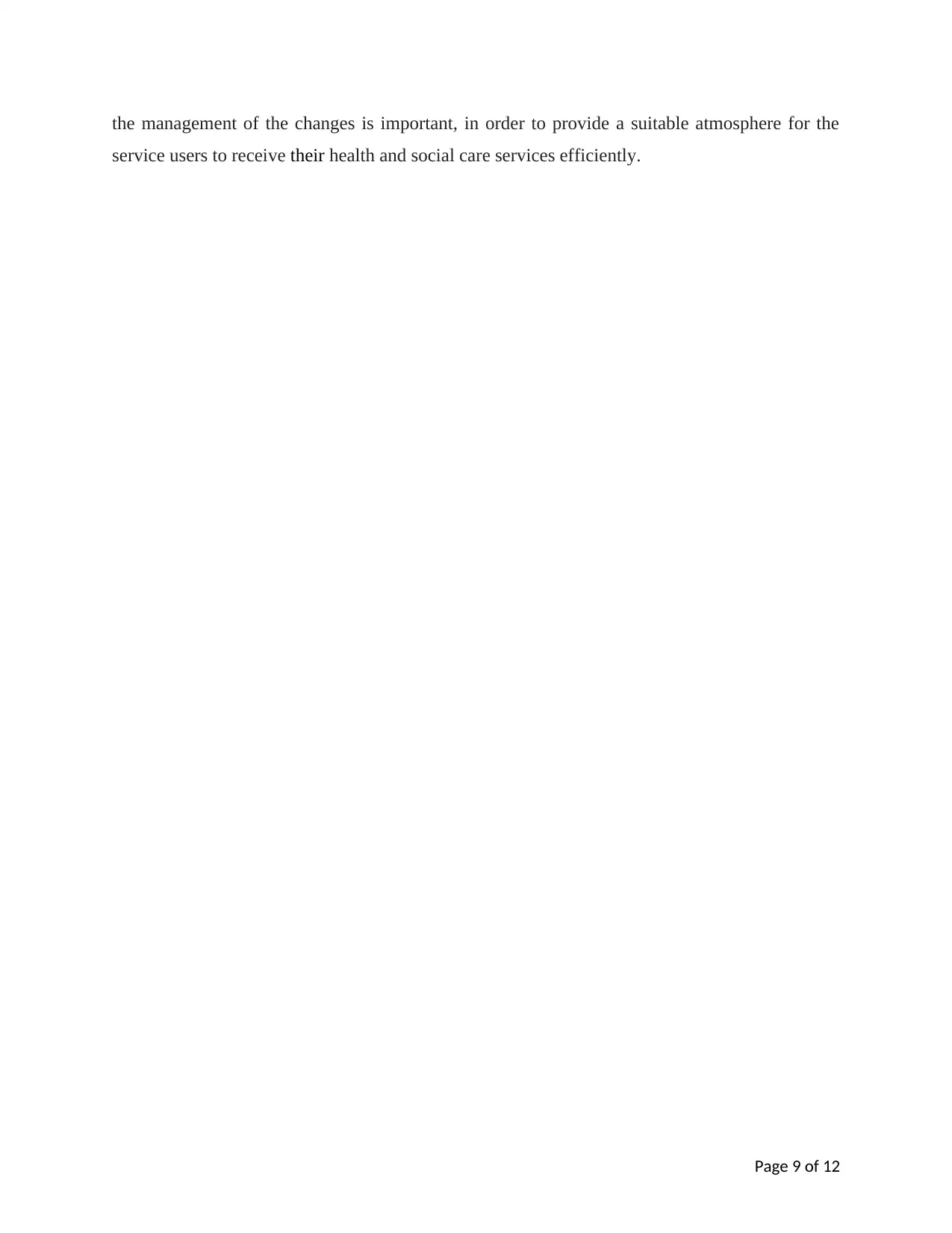
the management of the changes is important, in order to provide a suitable atmosphere for the
service users to receive their health and social care services efficiently.
Page 9 of 12
service users to receive their health and social care services efficiently.
Page 9 of 12
⊘ This is a preview!⊘
Do you want full access?
Subscribe today to unlock all pages.

Trusted by 1+ million students worldwide
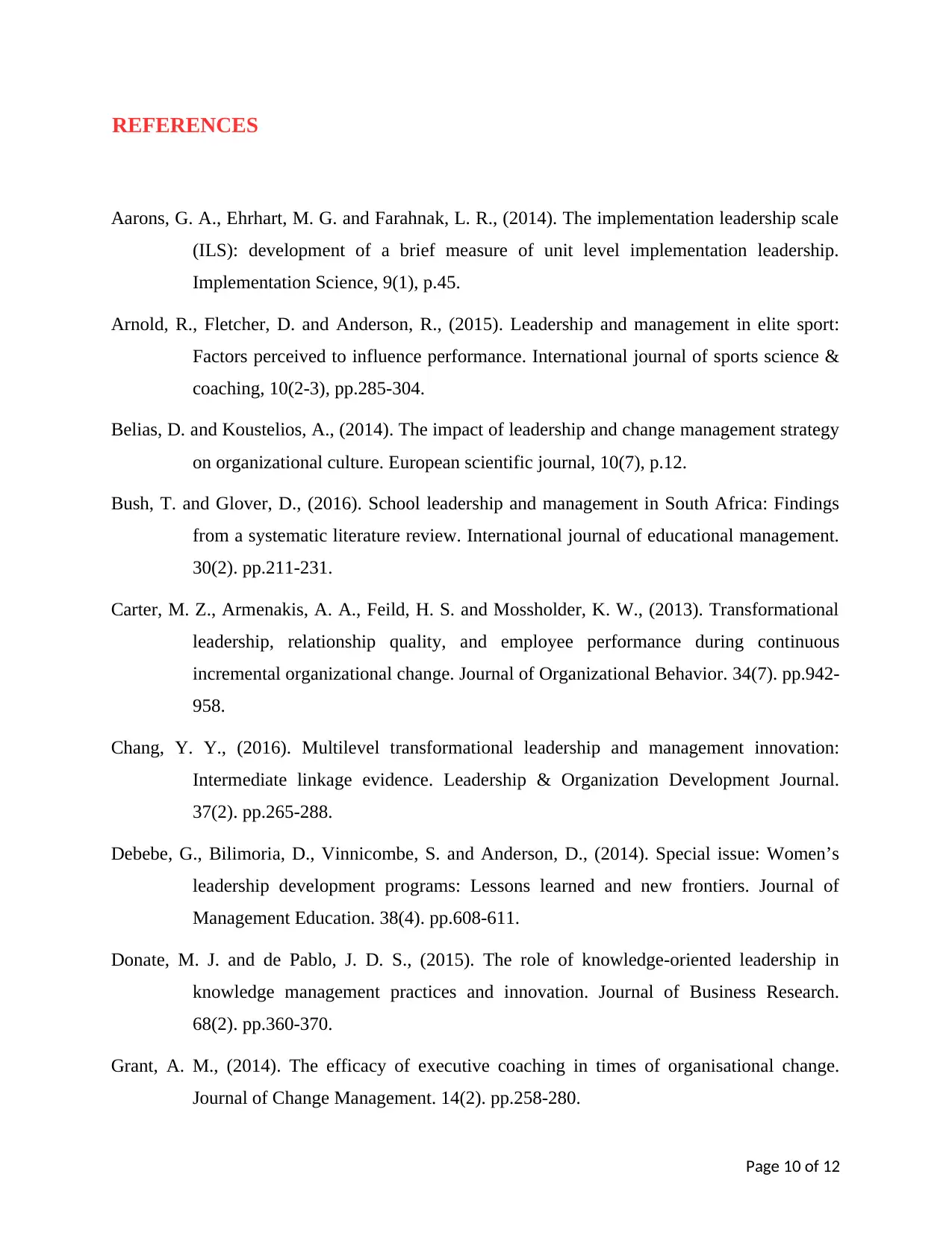
REFERENCES
Aarons, G. A., Ehrhart, M. G. and Farahnak, L. R., (2014). The implementation leadership scale
(ILS): development of a brief measure of unit level implementation leadership.
Implementation Science, 9(1), p.45.
Arnold, R., Fletcher, D. and Anderson, R., (2015). Leadership and management in elite sport:
Factors perceived to influence performance. International journal of sports science &
coaching, 10(2-3), pp.285-304.
Belias, D. and Koustelios, A., (2014). The impact of leadership and change management strategy
on organizational culture. European scientific journal, 10(7), p.12.
Bush, T. and Glover, D., (2016). School leadership and management in South Africa: Findings
from a systematic literature review. International journal of educational management.
30(2). pp.211-231.
Carter, M. Z., Armenakis, A. A., Feild, H. S. and Mossholder, K. W., (2013). Transformational
leadership, relationship quality, and employee performance during continuous
incremental organizational change. Journal of Organizational Behavior. 34(7). pp.942-
958.
Chang, Y. Y., (2016). Multilevel transformational leadership and management innovation:
Intermediate linkage evidence. Leadership & Organization Development Journal.
37(2). pp.265-288.
Debebe, G., Bilimoria, D., Vinnicombe, S. and Anderson, D., (2014). Special issue: Women’s
leadership development programs: Lessons learned and new frontiers. Journal of
Management Education. 38(4). pp.608-611.
Donate, M. J. and de Pablo, J. D. S., (2015). The role of knowledge-oriented leadership in
knowledge management practices and innovation. Journal of Business Research.
68(2). pp.360-370.
Grant, A. M., (2014). The efficacy of executive coaching in times of organisational change.
Journal of Change Management. 14(2). pp.258-280.
Page 10 of 12
Aarons, G. A., Ehrhart, M. G. and Farahnak, L. R., (2014). The implementation leadership scale
(ILS): development of a brief measure of unit level implementation leadership.
Implementation Science, 9(1), p.45.
Arnold, R., Fletcher, D. and Anderson, R., (2015). Leadership and management in elite sport:
Factors perceived to influence performance. International journal of sports science &
coaching, 10(2-3), pp.285-304.
Belias, D. and Koustelios, A., (2014). The impact of leadership and change management strategy
on organizational culture. European scientific journal, 10(7), p.12.
Bush, T. and Glover, D., (2016). School leadership and management in South Africa: Findings
from a systematic literature review. International journal of educational management.
30(2). pp.211-231.
Carter, M. Z., Armenakis, A. A., Feild, H. S. and Mossholder, K. W., (2013). Transformational
leadership, relationship quality, and employee performance during continuous
incremental organizational change. Journal of Organizational Behavior. 34(7). pp.942-
958.
Chang, Y. Y., (2016). Multilevel transformational leadership and management innovation:
Intermediate linkage evidence. Leadership & Organization Development Journal.
37(2). pp.265-288.
Debebe, G., Bilimoria, D., Vinnicombe, S. and Anderson, D., (2014). Special issue: Women’s
leadership development programs: Lessons learned and new frontiers. Journal of
Management Education. 38(4). pp.608-611.
Donate, M. J. and de Pablo, J. D. S., (2015). The role of knowledge-oriented leadership in
knowledge management practices and innovation. Journal of Business Research.
68(2). pp.360-370.
Grant, A. M., (2014). The efficacy of executive coaching in times of organisational change.
Journal of Change Management. 14(2). pp.258-280.
Page 10 of 12
Paraphrase This Document
Need a fresh take? Get an instant paraphrase of this document with our AI Paraphraser
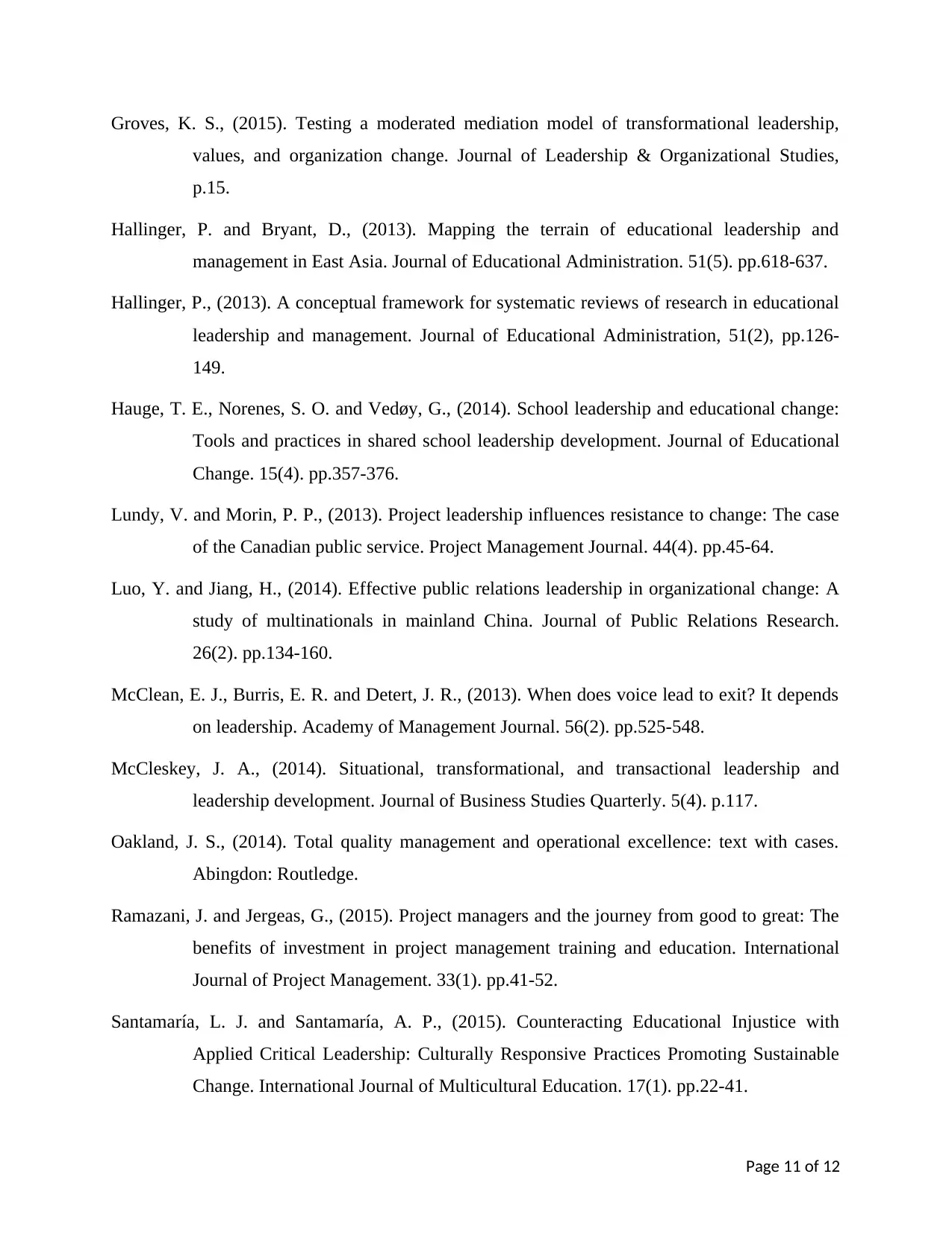
Groves, K. S., (2015). Testing a moderated mediation model of transformational leadership,
values, and organization change. Journal of Leadership & Organizational Studies,
p.15.
Hallinger, P. and Bryant, D., (2013). Mapping the terrain of educational leadership and
management in East Asia. Journal of Educational Administration. 51(5). pp.618-637.
Hallinger, P., (2013). A conceptual framework for systematic reviews of research in educational
leadership and management. Journal of Educational Administration, 51(2), pp.126-
149.
Hauge, T. E., Norenes, S. O. and Vedøy, G., (2014). School leadership and educational change:
Tools and practices in shared school leadership development. Journal of Educational
Change. 15(4). pp.357-376.
Lundy, V. and Morin, P. P., (2013). Project leadership influences resistance to change: The case
of the Canadian public service. Project Management Journal. 44(4). pp.45-64.
Luo, Y. and Jiang, H., (2014). Effective public relations leadership in organizational change: A
study of multinationals in mainland China. Journal of Public Relations Research.
26(2). pp.134-160.
McClean, E. J., Burris, E. R. and Detert, J. R., (2013). When does voice lead to exit? It depends
on leadership. Academy of Management Journal. 56(2). pp.525-548.
McCleskey, J. A., (2014). Situational, transformational, and transactional leadership and
leadership development. Journal of Business Studies Quarterly. 5(4). p.117.
Oakland, J. S., (2014). Total quality management and operational excellence: text with cases.
Abingdon: Routledge.
Ramazani, J. and Jergeas, G., (2015). Project managers and the journey from good to great: The
benefits of investment in project management training and education. International
Journal of Project Management. 33(1). pp.41-52.
Santamaría, L. J. and Santamaría, A. P., (2015). Counteracting Educational Injustice with
Applied Critical Leadership: Culturally Responsive Practices Promoting Sustainable
Change. International Journal of Multicultural Education. 17(1). pp.22-41.
Page 11 of 12
values, and organization change. Journal of Leadership & Organizational Studies,
p.15.
Hallinger, P. and Bryant, D., (2013). Mapping the terrain of educational leadership and
management in East Asia. Journal of Educational Administration. 51(5). pp.618-637.
Hallinger, P., (2013). A conceptual framework for systematic reviews of research in educational
leadership and management. Journal of Educational Administration, 51(2), pp.126-
149.
Hauge, T. E., Norenes, S. O. and Vedøy, G., (2014). School leadership and educational change:
Tools and practices in shared school leadership development. Journal of Educational
Change. 15(4). pp.357-376.
Lundy, V. and Morin, P. P., (2013). Project leadership influences resistance to change: The case
of the Canadian public service. Project Management Journal. 44(4). pp.45-64.
Luo, Y. and Jiang, H., (2014). Effective public relations leadership in organizational change: A
study of multinationals in mainland China. Journal of Public Relations Research.
26(2). pp.134-160.
McClean, E. J., Burris, E. R. and Detert, J. R., (2013). When does voice lead to exit? It depends
on leadership. Academy of Management Journal. 56(2). pp.525-548.
McCleskey, J. A., (2014). Situational, transformational, and transactional leadership and
leadership development. Journal of Business Studies Quarterly. 5(4). p.117.
Oakland, J. S., (2014). Total quality management and operational excellence: text with cases.
Abingdon: Routledge.
Ramazani, J. and Jergeas, G., (2015). Project managers and the journey from good to great: The
benefits of investment in project management training and education. International
Journal of Project Management. 33(1). pp.41-52.
Santamaría, L. J. and Santamaría, A. P., (2015). Counteracting Educational Injustice with
Applied Critical Leadership: Culturally Responsive Practices Promoting Sustainable
Change. International Journal of Multicultural Education. 17(1). pp.22-41.
Page 11 of 12
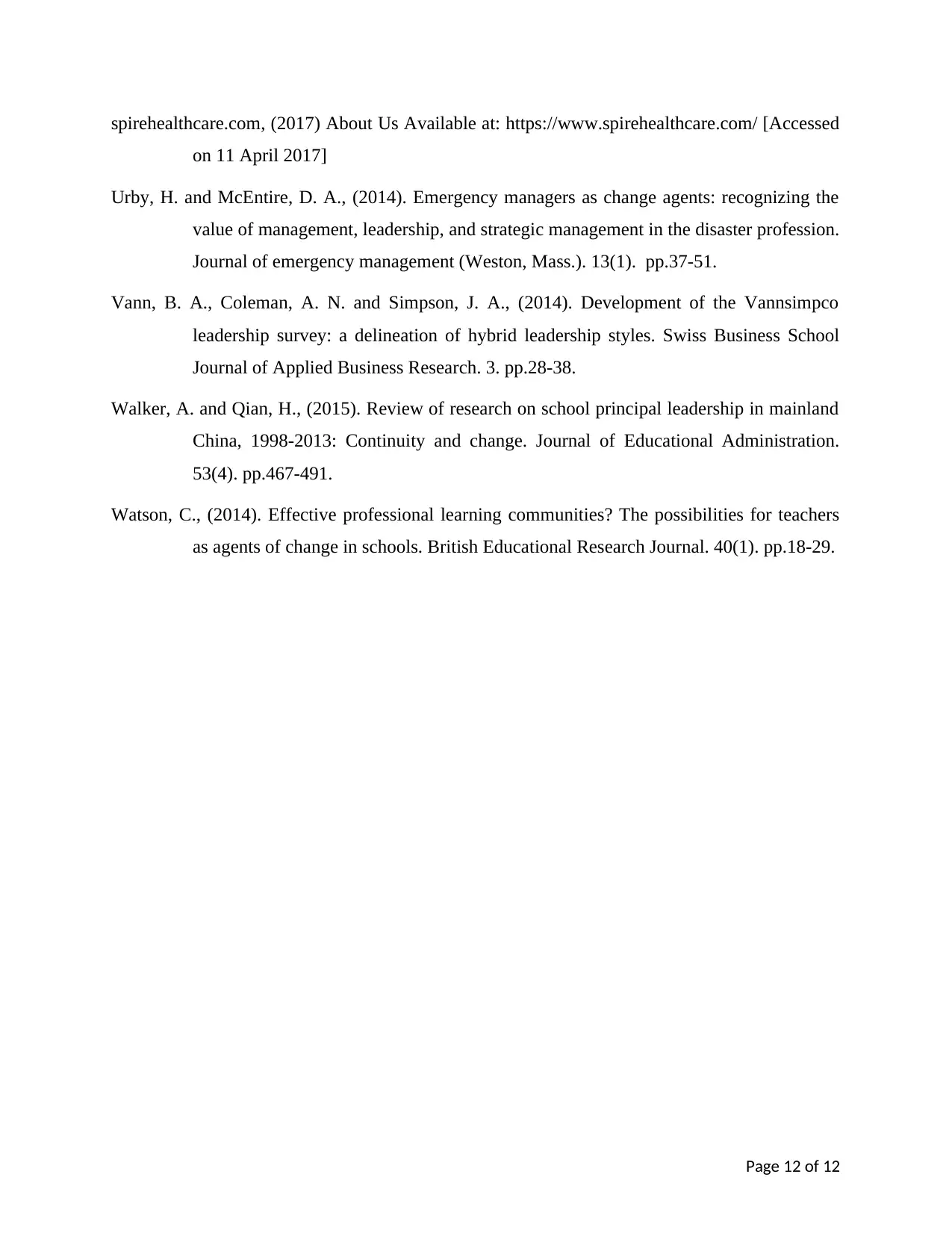
spirehealthcare.com, (2017) About Us Available at: https://www.spirehealthcare.com/ [Accessed
on 11 April 2017]
Urby, H. and McEntire, D. A., (2014). Emergency managers as change agents: recognizing the
value of management, leadership, and strategic management in the disaster profession.
Journal of emergency management (Weston, Mass.). 13(1). pp.37-51.
Vann, B. A., Coleman, A. N. and Simpson, J. A., (2014). Development of the Vannsimpco
leadership survey: a delineation of hybrid leadership styles. Swiss Business School
Journal of Applied Business Research. 3. pp.28-38.
Walker, A. and Qian, H., (2015). Review of research on school principal leadership in mainland
China, 1998-2013: Continuity and change. Journal of Educational Administration.
53(4). pp.467-491.
Watson, C., (2014). Effective professional learning communities? The possibilities for teachers
as agents of change in schools. British Educational Research Journal. 40(1). pp.18-29.
Page 12 of 12
on 11 April 2017]
Urby, H. and McEntire, D. A., (2014). Emergency managers as change agents: recognizing the
value of management, leadership, and strategic management in the disaster profession.
Journal of emergency management (Weston, Mass.). 13(1). pp.37-51.
Vann, B. A., Coleman, A. N. and Simpson, J. A., (2014). Development of the Vannsimpco
leadership survey: a delineation of hybrid leadership styles. Swiss Business School
Journal of Applied Business Research. 3. pp.28-38.
Walker, A. and Qian, H., (2015). Review of research on school principal leadership in mainland
China, 1998-2013: Continuity and change. Journal of Educational Administration.
53(4). pp.467-491.
Watson, C., (2014). Effective professional learning communities? The possibilities for teachers
as agents of change in schools. British Educational Research Journal. 40(1). pp.18-29.
Page 12 of 12
⊘ This is a preview!⊘
Do you want full access?
Subscribe today to unlock all pages.

Trusted by 1+ million students worldwide
1 out of 12
Related Documents
Your All-in-One AI-Powered Toolkit for Academic Success.
+13062052269
info@desklib.com
Available 24*7 on WhatsApp / Email
![[object Object]](/_next/static/media/star-bottom.7253800d.svg)
Unlock your academic potential
Copyright © 2020–2025 A2Z Services. All Rights Reserved. Developed and managed by ZUCOL.





